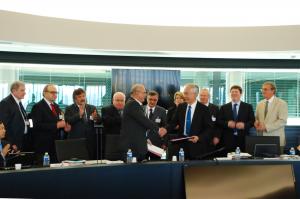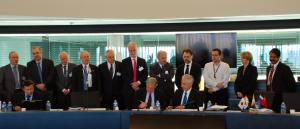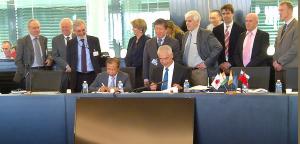Signatures in the wings of Council
With representatives from the seven ITER Members gathered for last week's extraordinary ITER Council meeting, it was the perfect opportunity to finalize the signatures on four agreements, each one representing a step forward in ITER Construction.
The first agreement signed increases ITER Organization property by 10 hectares. When the ITER Organization and the Host Organization CEA signed the Site Support Agreement in November 2009 it was specified that "... the Host Organization shall make available through a specific act to the ITER Organization an area of land," consisting of approximately 181 hectares. On 6 July 2010, around 100 of the 181 hectares were transferred the ITER Organization by notarial deed. This year the ITER Organization requested the transfer of a second portion of land from CEA—approximately 10 hectares—in order to prepare a storage/logistics platform for the storage of ITER components as well as for the unpacking and repacking necessary for assembly activities.
The second agreement marks the kick-off for the design and procurement of the first Test Blanket System, a vital step on the way to tritium self-sufficiency. A reliable and efficient "breeder blanket" technology will be necessary for heat transfer and fuel generation in future fusion power plants and ITER will provide a unique opportunity to test the mockups of these breeding blankets, called Test Blanket Systems, in a real fusion environment. Among the key milestones along the road to procurement are the signing of six specific TBM Arrangements that correspond to the formal implementation of six Test Blanket Systems in ITER.
Almost 20 years after the establishment of a first ITER Test Blanket Working Group, and not quite two years after the endorsement of the generic TBM Arrangement by the ITER Council, the ITER Organization and the Chinese Domestic Agency signed an arrangement last week for the design, manufacturing, transport and delivery of a Helium-Cooled Ceramic Breeder test blanket system to the ITER site by 2021. This is the first of six TBM Arrangements expected be signed in the course of the year.
Also signed last week was a Procurement Arrangement with the Russian Domestic Agency for the enhanced heat flux first wall panels for the ITER Blanket System. The signature opens the way for the fabrication of these key components that, as they directly face the plasma, will have to withstand the highest heat flux of the machine (up to 4.7 MW/m2). The Russian Domestic Agency will procure 171 enhanced heat flux first wall panels (plus 8 spares), for installation in the upper and outboard regions of the vacuum vessel. As the first Procurement Arrangement signed for blanket first wall panels, this was a milestone event; two further Procurement Arrangements for this system will be signed in 2015 with China (for the remaining enhanced heat flux first wall panels) and Europe (for the normal heat flux panels).
Finally, a document was signed with the United States relative to the supply of materials for the ITER plant's steady state electrical network (400 kV gantries for the overhead lines of the steady state electrical network and metal structures to support the 400kV electrical equipment gantries and structures). Although the provision of this equipment had originally been assigned to the United States, it was later agreed by all parties that there were advantages to procuring the same gantry and structures as those used by the French electricity transmission network RTE for the Prionnet substation. As of last week's agreement, the scope has been transferred to the ITER Organization.




